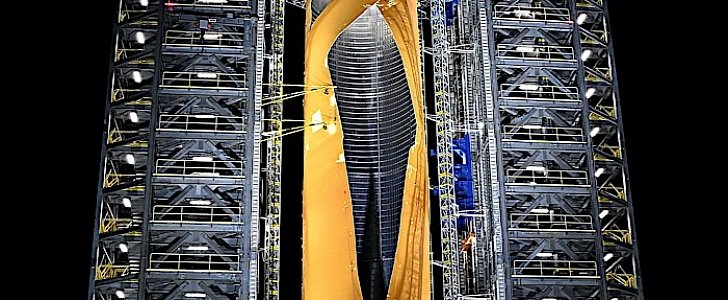When completed, the NASA Space Launch System rocket will be the main tool of transportation for humans to the Moon and possibly beyond. More importantly, it will be the only rocket, commercial or otherwise, capable of sending astronauts, the Orion capsule and supplies to the Moon in a single go.
We’re still a long way from that, but that doesn’t mean exciting developments aren’t already taking place. This past weekend, NASA and Boeing, the main contractor for the SLS, completed the last test on the liquid hydrogen tank that will eventually help the rocket get off the ground. And by completed, we mean utterly destroyed.
The test was meant to show how long the tank can withstand incredible flight loads before exploding. And the results show it can take a lot.
For about five hours, the test tank was subjected to immense loads coming from pressurized nitrogen gas and hydraulic pistons that squeezed it with the force of millions of pounds.
The SLS will never have to withstands such pressure for so long, but NASA did it anyway, and found out the tank can withstand 260 percent of the expected flight loads before giving way.
As seen in the video posted by the agency’s administrator Jim Bridenstine on Twitter (available below), the tank at one point ruptures along full length, at the exact location predicted by Boeing engineers and within 3 percent of the predicted load.
“Success! Engineers @NASA_Marshall tested the @NASA_SLS liquid hydrogen test article tank to failure – the tank withstood more than 260% of expected flight loads before buckling and rupturing!” Bridenstine said.
With this last hurdle overcome (it was the largest-ever controlled test-to-failure of a NASA rocket stage pressurized tank), and the previous ones aced, the fuel tank (not the one that blew up, of course) is deemed ready for operation. It will be fitted on two upcoming variants of the SLS – Block 1 and Block 1B.
The first flight of the SLS is called Artemis 1 and at the time of this writing is scheduled for November 2020.
The test was meant to show how long the tank can withstand incredible flight loads before exploding. And the results show it can take a lot.
For about five hours, the test tank was subjected to immense loads coming from pressurized nitrogen gas and hydraulic pistons that squeezed it with the force of millions of pounds.
The SLS will never have to withstands such pressure for so long, but NASA did it anyway, and found out the tank can withstand 260 percent of the expected flight loads before giving way.
As seen in the video posted by the agency’s administrator Jim Bridenstine on Twitter (available below), the tank at one point ruptures along full length, at the exact location predicted by Boeing engineers and within 3 percent of the predicted load.
“Success! Engineers @NASA_Marshall tested the @NASA_SLS liquid hydrogen test article tank to failure – the tank withstood more than 260% of expected flight loads before buckling and rupturing!” Bridenstine said.
With this last hurdle overcome (it was the largest-ever controlled test-to-failure of a NASA rocket stage pressurized tank), and the previous ones aced, the fuel tank (not the one that blew up, of course) is deemed ready for operation. It will be fitted on two upcoming variants of the SLS – Block 1 and Block 1B.
The first flight of the SLS is called Artemis 1 and at the time of this writing is scheduled for November 2020.
Success! Engineers @NASA_Marshall tested the @NASA_SLS liquid hydrogen test article tank to failure – the tank withstood more than 260% of expected flight loads before buckling and rupturing! #Artemis MORE: https://t.co/xznmov26FP pic.twitter.com/qAIyapEJA5
— Jim Bridenstine (@JimBridenstine) December 9, 2019

